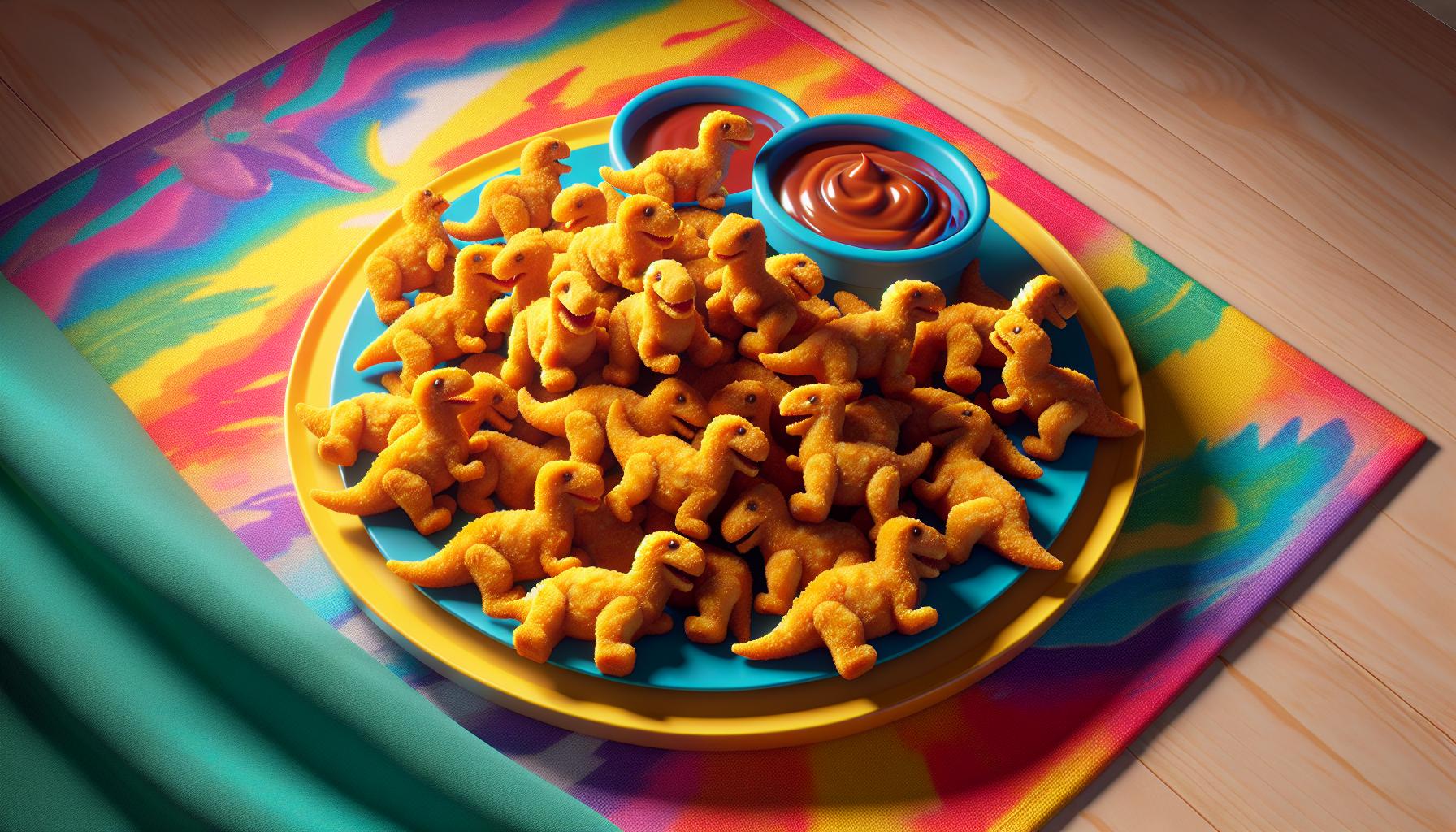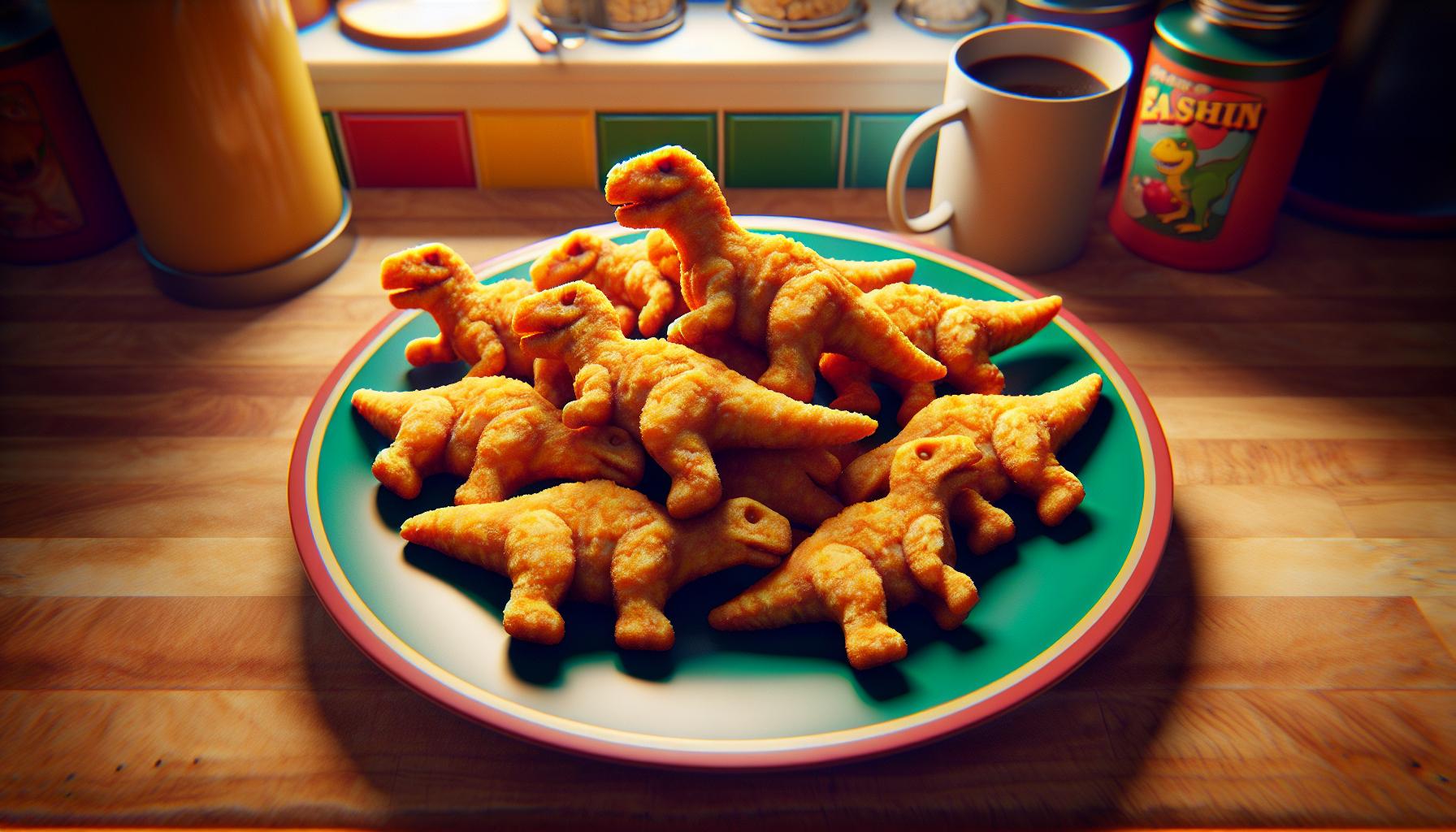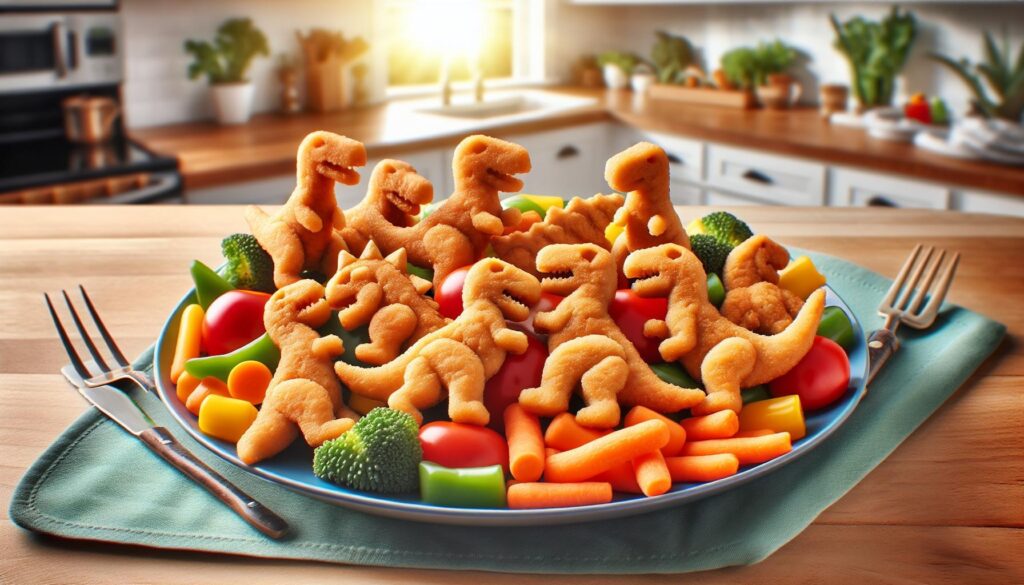Dinosaur-shaped chicken nuggets bring out the inner child in everyone, but what’s really hiding beneath those prehistoric-inspired crispy bites? While these fun-shaped nuggets might make mealtime more exciting, understanding their nutritional content is crucial for making informed dietary choices.
The popularity of dino nuggets has soared among both kids and adults who embrace their playful nature. These breaded wonders often pack more than just nostalgia and entertainment value – they come with specific nutritional profiles that health-conscious consumers should know about. Whether they’re destined for a quick after-school snack or a guilty pleasure midnight feast, it’s time to decode what’s really stomping through those ingredient lists.
Dino Nuggets Nutrition Label
Dino nuggets are breaded chicken pieces shaped like prehistoric dinosaur species including T-Rex, Stegosaurus, Triceratops and Brontosaurus. These shaped nuggets contain white meat chicken combined with breading ingredients such as wheat flour, water, vegetable oil and seasonings.
Popular brands like Tyson, Perdue and Yummy offer dino nuggets in frozen form for quick preparation. The nuggets undergo a flash-freezing process after being formed, breaded and partially cooked to maintain their distinctive dinosaur shapes.
The production process involves:
- Grinding chicken meat into a paste
- Molding the meat mixture into dinosaur shapes
- Coating with seasoned breading
- Par-frying to set the exterior
- Flash freezing for preservation
Common serving sizes range from 4-6 pieces per portion, with most packages containing 20-50 nuggets. The nuggets require heating in an oven, microwave or air fryer before consumption to reach food-safe temperatures of 165°F (74°C).
Key ingredients typically include:
| Component | Purpose |
|---|---|
| White meat chicken | Main protein source |
| Wheat flour | Primary breading base |
| Vegetable oil | Helps achieve crispy texture |
| Salt & spices | Enhance flavor profile |
| Modified food starch | Maintains shape integrity |
The nuggets maintain their dinosaur shapes through the cooking process, making them visually appealing especially to young consumers. Each piece measures approximately 2-3 inches in length, creating an engaging eating experience that combines familiar chicken nugget taste with prehistoric themed shapes.
Nutritional Facts and Values

Understanding the nutritional content of dinosaur-shaped chicken nuggets enables informed dietary decisions. The nutritional values vary among brands with slight differences in ingredients formulations.
Calories and Serving Size
A typical serving of 4-5 dinosaur-shaped chicken nuggets contains 200-230 calories. Tyson Fun Nuggets provides 200 calories per 5-piece serving (87g), while Perdue offers 210 calories for a 4-piece portion (85g). The serving size calculation includes the breaded coating weight along with the white meat chicken content.
| Brand | Serving Size | Calories |
|---|---|---|
| Tyson | 5 pieces (87g) | 200 |
| Perdue | 4 pieces (85g) | 210 |
Protein and Fat Content
Dino nuggets deliver 10-12 grams of protein per serving from white meat chicken. Total fat content ranges from 12-14 grams per serving with 2-3 grams of saturated fat. The protein content supports muscle maintenance while the fat content contributes to the nuggets’ crispy texture.
| Nutrient | Amount per Serving |
|---|---|
| Protein | 10-12g |
| Total Fat | 12-14g |
| Saturated Fat | 2-3g |
Carbohydrates and Fiber
Each serving contains 15-18 grams of total carbohydrates from the breading mixture. The fiber content remains minimal at 1-2 grams per serving. The breading ingredients include enriched wheat flour plus cornstarch which creates the distinctive crispy exterior coating.
| Nutrient | Amount per Serving |
|---|---|
| Total Carbs | 15-18g |
| Dietary Fiber | 1-2g |
| Added Sugars | <1g |
Key Ingredients Analysis

Dino nuggets contain a specific combination of ingredients that contribute to their taste, texture, and nutritional profile. A detailed analysis reveals both essential components and additional substances used in their production.
Main Components
The primary ingredients in dino nuggets include white meat chicken, wheat flour, and vegetable oil. The chicken component comprises 40-50% of the nugget, delivering essential protein. The breading mixture contains enriched wheat flour, yellow corn flour, and modified food starch, creating the distinctive crispy exterior. Salt, spices, and natural flavors enhance the taste profile, while water maintains moisture content. Key binding agents like dried yeast and modified corn starch help maintain the dinosaur shapes during cooking.
Preservatives and Additives
Common preservatives in dino nuggets include BHT, sodium phosphates, and potassium chloride. These additives extend shelf life and maintain product stability in frozen storage. Natural flavor enhancers such as autolyzed yeast extract add depth to the taste. Dextrose serves as both a sweetener and browning agent during cooking. Many brands incorporate vitamin enrichments like thiamine mononitrate, riboflavin, and niacin into the breading. Added minerals include calcium propionate for freshness preservation and sodium acid pyrophosphate to maintain color.
Health Considerations

Dinosaur-shaped chicken nuggets present distinct nutritional implications for consumers’ dietary choices. Understanding these aspects helps in making informed decisions about incorporating them into meal plans.
Benefits vs Drawbacks
Dino nuggets provide 10-12 grams of protein per serving, supporting muscle maintenance essential for growing children. The white meat chicken content delivers lean protein with essential amino acids. These nuggets contain vitamin enrichments including iron zinc calcium which supplement daily nutrient requirements.
The drawbacks include high sodium content ranging from 400-500mg per serving (20% daily value). The breading contributes 12-14 grams of fat per serving with 2-3 grams being saturated fat. The par-frying process adds extra calories making them more energy-dense compared to non-breaded chicken options.
Dietary Restrictions
Dino nuggets contain wheat gluten making them unsuitable for individuals with celiac disease or gluten sensitivity. The breading ingredients include common allergens such as wheat soy eggs. Cross-contamination risks exist in manufacturing facilities that process multiple allergens.
People following kosher halal diets must verify specific brand certifications. Individuals monitoring sodium intake face restrictions due to the high salt content. Low-carb diet followers encounter limitations from the 15-18 grams of carbohydrates per serving primarily from breading components.
| Dietary Concern | Restriction Level |
|---|---|
| Gluten-Free | Not Suitable |
| Common Allergens | Contains Wheat Soy Eggs |
| Sodium Restricted | Limited (400-500mg/serving) |
| Low-Carb | Limited (15-18g/serving) |
Tips for Healthier Consumption
Air frying dino nuggets creates a crispier texture with 25% less fat than traditional oven baking.
Here are practical ways to enhance the nutritional value of dinosaur nuggets:
- Pair nuggets with colorful vegetables like steamed broccoli or carrot sticks
- Serve with homemade dipping sauces using Greek yogurt or hummus
- Limit portions to 4-5 pieces per serving
- Choose baked preparation methods over deep frying
- Select whole grain breaded varieties when available
Creating balanced meals with dino nuggets involves strategic side dish choices:
- Add fiber rich sides:
- Roasted sweet potato wedges
- Quinoa or brown rice
- Steamed green beans
- Include fresh produce:
- Mixed green salad
- Raw vegetable sticks
- Fresh fruit pieces
Smart preparation methods optimize nutrition:
| Cooking Method | Fat Content | Cooking Time |
|---|---|---|
| Air Fryer | 10g | 8-10 mins |
| Oven Baked | 13g | 15-20 mins |
| Deep Fried | 18g | 3-5 mins |
- Lower sodium content (under 400mg per serving)
- Reduced fat options (less than 10g per serving)
- Minimal artificial ingredients
- Higher protein content (12g or more per serving)
Dino nuggets remain a beloved mealtime option that brings joy to dining tables worldwide. While they offer a good source of protein and essential nutrients they should be enjoyed as part of a balanced diet with mindful portion control. By choosing healthier cooking methods and pairing them with nutritious sides consumers can maximize their enjoyment of these fun-shaped nuggets while maintaining their nutritional goals.
Understanding the nutrition label helps make informed decisions about incorporating dino nuggets into meal plans. Smart preparation choices and thoughtful serving suggestions transform these whimsical treats into a reasonable component of a wholesome diet that both kids and adults can enjoy responsibly.

